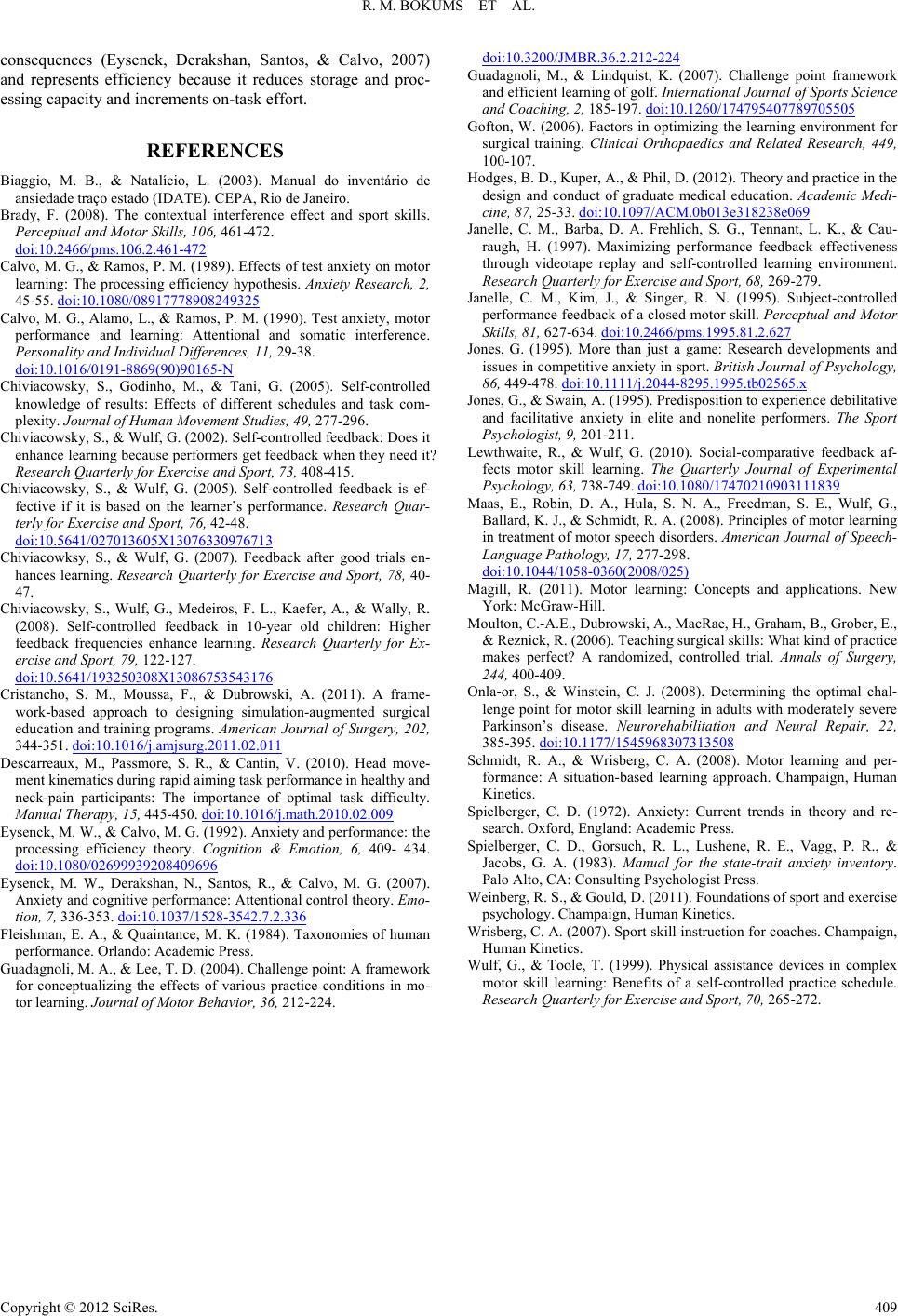
R. M. BOKUMS ET AL.
consequences (Eysenck, Derakshan, Santos, & Calvo, 2007)
and represents efficiency because it reduces storage and proc-
essing capacity and increments on-task effort.
REFERENCES
Biaggio, M. B., & Natalício, L. (2003). Manual do inventário de
ansiedade traço estado (IDATE). CEPA, Rio de Janeiro.
Brady, F. (2008). The contextual interference effect and sport skills.
Perceptual and Motor Skills, 106, 461-472.
doi:10.2466/pms.106.2.461-472
Calvo, M. G., & Ramos, P. M. (1989). Effects of test anxiety on motor
learning: The processing efficiency hypothesis. Anxiety Research, 2,
45-55. doi:10.1080/08917778908249325
Calvo, M. G., Alamo, L., & Ramos, P. M. (1990). Test anxiety, motor
performance and learning: Attentional and somatic interference.
Personality and Individual Differences, 11, 29-38.
doi:10.1016/0191-8869(90)90165-N
Chiviacowsky, S., Godinho, M., & Tani, G. (2005). Self-controlled
knowledge of results: Effects of different schedules and task com-
plexity. Journal of H um an Mo ve me nt S tud ie s, 49, 277-296.
Chiviacowsky, S., & Wulf, G. (2002). Self-controlled feedback: Does it
enhance learning because performers get feedback when they need it?
Research Quarterly for Exercise a n d Sp or t , 73, 408-415.
Chiviacowsky, S., & Wulf, G. (2005). Self-controlled feedback is ef-
fective if it is based on the learner’s performance. Research Quar-
terly for Exercise and Sport, 76, 42-48.
doi:10.5641/027013605X13076330976713
Chiviacowksy, S., & Wulf, G. (2007). Feedback after good trials en-
hances learning. Research Quarterly for Exercise and Sport, 78, 40-
47.
Chiviacowsky, S., Wulf, G., Medeiros, F. L., Kaefer, A., & Wally, R.
(2008). Self-controlled feedback in 10-year old children: Higher
feedback frequencies enhance learning. Research Quarterly for Ex-
ercise and Sport, 79, 122-127.
doi:10.5641/193250308X13086753543176
Cristancho, S. M., Moussa, F., & Dubrowski, A. (2011). A frame-
work-based approach to designing simulation-augmented surgical
education and training programs. American Journal of Surgery, 202,
344-351. doi:10.1016/j.amjsurg.2011.02.011
Descarreaux, M., Passmore, S. R., & Cantin, V. (2010). Head move-
ment kinematics during rapid aiming task performance in healthy and
neck-pain participants: The importance of optimal task difficulty.
Manual Therapy, 15, 445-450. doi:10.1016/j.math.2010.02.009
Eysenck, M. W., & Calvo, M. G. (1992). Anxiety and performance: the
processing efficiency theory. Cognition & Emotion, 6, 409- 434.
doi:10.1080/02699939208409696
Eysenck, M. W., Derakshan, N., Santos, R., & Calvo, M. G. (2007).
Anxiety and cognitive performance: Attentional control theory. Emo-
tion, 7, 336-353. doi:10.1037/1528-3542.7.2.336
Fleishman, E. A., & Quaintance, M. K. (1984). Taxonomies of human
performance. Orlando: Academic Press.
Guadagnoli, M. A., & Lee, T. D. (2004). Challenge point: A framework
for conceptualizing the effects of various practice conditions in mo-
tor learning. Journal of Motor Behavior, 36, 212-224.
doi:10.3200/JMBR.36.2.212-224
Guadagnoli, M., & Lindquist, K. (2007). Challenge point framework
and efficient learning of golf. International Journal of Sports Science
and Coaching, 2, 185-197. doi:10.1260/174795407789705505
Gofton, W. (2006). Factors in optimizing the learning environment for
surgical training. Clinical Orthopaedics and Related Research, 449,
100-107.
Hodges, B. D., Kuper, A., & Phil, D. (2012). Theory and practice in the
design and conduct of graduate medical education. Academic Medi-
cine, 87, 25-33. doi:10.1097/ACM.0b013e318238e069
Janelle, C. M., Barba, D. A. Frehlich, S. G., Tennant, L. K., & Cau-
raugh, H. (1997). Maximizing performance feedback effectiveness
through videotape replay and self-controlled learning environment.
Research Quarterly for Exercise a n d Sp or t , 68, 269-279.
Janelle, C. M., Kim, J., & Singer, R. N. (1995). Subject-controlled
performance feedback of a closed motor skill. Perceptual and Motor
Skills, 81, 627-634. doi:10.2466/pms.1995.81.2.627
Jones, G. (1995). More than just a game: Research developments and
issues in competitive anxiety in sport. British Journal of Psychology,
86, 449-478. doi:10.1111/j.2044-8295.1995.tb02565.x
Jones, G., & Swain, A. (1995). Predisposition to experience debilitative
and facilitative anxiety in elite and nonelite performers. The Sport
Psychologist, 9, 201-211.
Lewthwaite, R., & Wulf, G. (2010). Social-comparative feedback af-
fects motor skill learning. The Quarterly Journal of Experimental
Psychology, 63, 738-749. doi:10.1080/17470210903111839
Maas, E., Robin, D. A., Hula, S. N. A., Freedman, S. E., Wulf, G.,
Ballard, K. J., & Schmidt, R. A. (2008). Principles of motor learning
in treatment of motor speech disorders. American Journal of Speech-
Language Pathology, 17, 277-298.
doi:10.1044/1058-0360(2008/025)
Magill, R. (2011). Motor learning: Concepts and applications. New
York: McGraw-Hill.
Moulton, C.-A.E., Dubrowski, A., MacRae, H., Graham, B., Grober, E.,
& Reznick, R. (2006). Teaching surgical skills: What kind of practice
makes perfect? A randomized, controlled trial. Annals of Surgery,
244, 400-409.
Onla-or, S., & Winstein, C. J. (2008). Determining the optimal chal-
lenge point for motor skill learning in adults with moderately severe
Parkinson’s disease. Neurorehabilitation and Neural Repair, 22,
385-395. doi:10.1177/1545968307313508
Schmidt, R. A., & Wrisberg, C. A. (2008). Motor learning and per-
formance: A situation-based learning approach. Champaign, Human
Kinetics.
Spielberger, C. D. (1972). Anxiety: Current trends in theory and re-
search. Oxford, England: Academic Press.
Spielberger, C. D., Gorsuch, R. L., Lushene, R. E., Vagg, P. R., &
Jacobs, G. A. (1983). Manual for the state-trait anxiety inventory.
Palo Alto, CA: Consulting Psychologist Press.
Weinberg, R. S., & Gould, D. (2011). Foundations of sport and exercise
psychology. Champaign, Human Kinetics.
Wrisberg, C. A. (2007). Sport skill instruction for coaches. Champaign,
Human Kinetics.
Wulf, G., & Toole, T. (1999). Physical assistance devices in complex
motor skill learning: Benefits of a self-controlled practice schedule.
Research Quarterly for Exercise a n d Sp or t , 70, 265-272.
Copyright © 2012 SciRes. 409